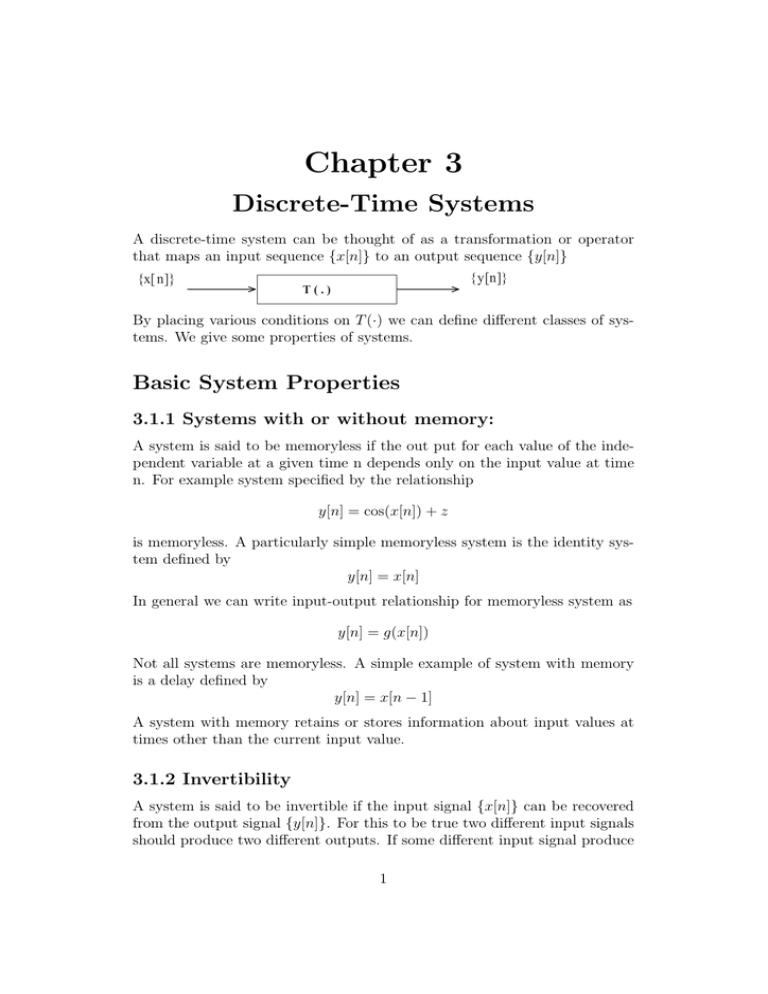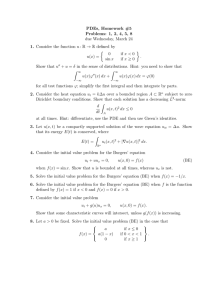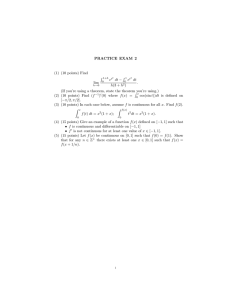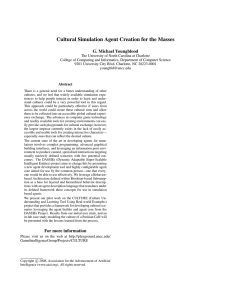Discrete-Time Systems: Properties & Analysis
advertisement

Chapter 3
Discrete-Time Systems
A discrete-time system can be thought of as a transformation or operator
that maps an input sequence {x[n]} to an output sequence {y[n]}
{x[ n]}
{y[n]}
T(.)
By placing various conditions on T (·) we can define different classes of systems. We give some properties of systems.
Basic System Properties
3.1.1 Systems with or without memory:
A system is said to be memoryless if the out put for each value of the independent variable at a given time n depends only on the input value at time
n. For example system specified by the relationship
y[n] = cos(x[n]) + z
is memoryless. A particularly simple memoryless system is the identity system defined by
y[n] = x[n]
In general we can write input-output relationship for memoryless system as
y[n] = g(x[n])
Not all systems are memoryless. A simple example of system with memory
is a delay defined by
y[n] = x[n − 1]
A system with memory retains or stores information about input values at
times other than the current input value.
3.1.2 Invertibility
A system is said to be invertible if the input signal {x[n]} can be recovered
from the output signal {y[n]}. For this to be true two different input signals
should produce two different outputs. If some different input signal produce
1
same output signal then by processing output we can not say which input
produced the output. Example of an invertible system is
n
y[n] =
x[k]
k=−∞
then
x[n] = y[n] − y[n − 1]
Example if a non-invertible system is
y[n] = 0
That is the system produces an all zero sequence for any input sequence.
Since every input sequence gives all zero sequence, we can not find out which
input produced the output.
The system which produces the sequence {x[n]} from sequence {y[n]} is
called the inverse system. In communication system, decoder is an inverse of
the encoder.
3.1.3 Causality
A system is causal if the output at anytime depends only on values of the
input at the present time and in the past.
y[n] = f (x[n], x[n − 1], ...)
All memoryless systems are causal. An accumulator system defined by
y[n] =
x[h]
is also causal. The system defined by
y[n] =
N
1
x[n − k]
2N + 1 k=−N
is noncausal.
For real time system where n actually denoted time causalities is important.
Causality is not an essential constraint in applications where n is not time,
for example, image processing. If we case doing processing on recorded data,
then also causality may not be required.
2
3.1.4 Stability
There are several definitions for stability. Here we will consider bounded
input bonded output(BIBO) stability. A system is said to be BIBO stable
if every bounded input produces a bounded output. We say that a signal
{x[n]} is bounded if
|x[n]| < M < ∞
for all n
The moving averafe system
N
1
y[n] =
x[n]
2N + 1 k=−N
is stable as y[n] is sum of finite numbers and so it is bounded. The accumulator system defined by
n
x[k]
y[n] =
k=−∞
is unstable. If we take {x[n]} = {u[n]}, the unit step then y[0] = 1, y[1] =
2, y[2] = 3, arey[n] = n + 1, n ≥ 0 so y[n] grows without bound.
3.1.5 Time invariance
A system is said to be time invariant if the behavior and characteristics of the
system do not change with time.Thus a system is said to be time invariant
if a time delay or time advance in the input signal leads to identical delay or
advance in the output signal. Mathematically if
{y[n]} = T ({x[n]})
then
{y[n − n0 ]} = T ({x[n − n0 ]}) for any n0
Let us consider the accumulator system
y[n] =
n
x[k]
k=−∞
If the input is now {x1 [n]} = {x[n − n0 ]} then the corresponding output is
y1 [n] =
n
k=−∞
3
x1 [k]
=
n
x[k]
k=−∞
The shifted output signal is given by
y[n − n0 ] ==
n−n
0
x[k]
k=−∞
The two expression look different, but infact they are equal. Let us change
the index of summation by l = k − n0 in the first sum then we see that
n−n
0
y1 [n] ==
x[l]
l=−∞
= y[n − n0 ]
Hence, {y[n]} = {y[n − n0 ]} and the system is time-invariant. As a second
example consider the system defined by
y[n] = nx[n]
if
{x1 [n]} = {x[n − n0 ]}
y1 [n] = nx1 [n] = nx[n − n0 ]
while
y[n − n0 ] = (n − n0 )x[n − n0 ]
and so the system is not time-invariant. It is time varying. We can also
see this by giving a counter example. Suppose input is {x[n]} = {δ[n]} then
output is all zero sequence. If the input is {δ[n − 1]} then output is {δ[n − 1]}
which is definitely not a shifted version version of all zero sequence.
3.1.6 Linearity
This is an important property of the system. We will see later that if we
have system which is linear and time invariant then it has a very compact
representation. A linear system possesses the important property of superposition: if an input consists of weighted sum of several signals, the nthe
output is also weighted sum of the responses of the system to each of those
input signals. Mathematically let {y1 [n]} be the response of the system to
the input {x1 [n]} and let {y2 [n]} be the response of the system to the input
{x2 [n]}. Then the system is linear if:
4
1. Additivity: The response to {x[ n]} + {x2 [n]} is {y1 [n]} + {y2 [n]}
2. Homogeneity: The response to a{x1 [n]} is a{y1 [n]}, where a is any real
number if we are considering only real signals and a is any complex
number if we are considering complex valued signals.
3. Continuity: Let us consider {x1 [n]}, {x2 [n]}, ...{xk [n]}... be countably
infinite number of signals such that
lim {xk [n]} = {x[n]}
k→∞
Let the corresponding output signals be denoted by {yn [n]} and lim {yn [n]} =
k→∞
{y[n]}
We say that system posseses the continuity property if the response of the
system to the limiting input {x[n]} is limit of the responses {y[n]}.
T ( lim {xk [n]}) = lim T ({Xk [n]})
k→∞
k→∞
The additivity and continuity properties can be replaced by requiring that
system is additive for countably infinite number if signals i.e. response to
is {y1 [n]}+{y2 [n]}+...+{yk [n]}+....
{x1 [n]}+{x2 [n]}+...+{xn [n]}+...
Most of the books do not mention the continuity property. They state only
finite additivity and homogeneity. But from finite additivity we can not
deduce c....... additivity. This distinction becomes very important in continuous time systems.
A system can be linear without being time invariant and it can be time invariant without being linear. If a system is linear, an all zero input sequence
will produce a all zero output sequence. Let {0} denote the all zero sequence
,then {0} = 0.{x[n]}. If T ({x[n]} = {y[n]}) then by homogeneity property
T (0.{x[n]}) = 0.{y[n]}
or
T ({0}) = {0}
Consider the system defined by
y[n] = 2x[n] + 3
This system is not linear. This can be verified in several ways. If the input
is all zero sequence {0}, the output is not an all zero sequence. Although
the defining equation is a linear equation is x and y the system is nonlinear.
The output of this system can be represented as sum of a linear system and
5
another signal equal to the zero input response. In this case the linear system
is
y[n] = 2x[n]
and the zero-input response is
y0 [n] = 3 for all n
{y 0 [n]}
{x[ n]}
+
Linear System
{y[n]}
systems correspond to the class of incrementally linear system. System is linear in term of differnce signal i.e if we define {xd [n]} = {x1 [n]} − {X2 [n]}
and {yd [n]} = {y1 [n]} − {y2 [n]}. Then in terms of {xd [n]} and {yd [n]} the
system is linear.
6
Such




